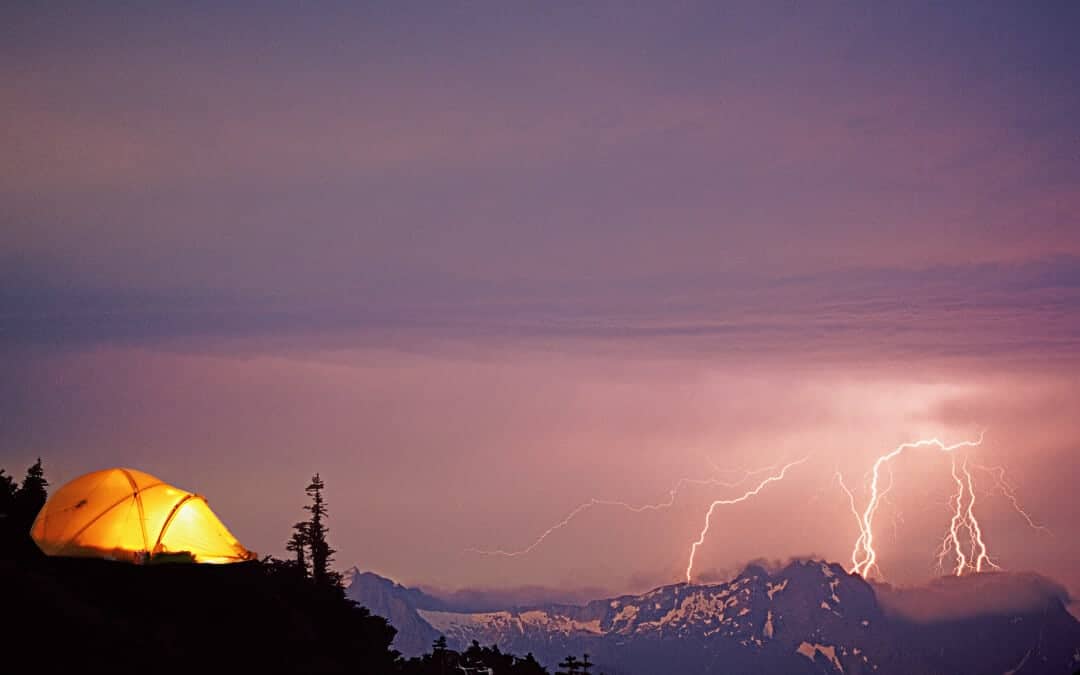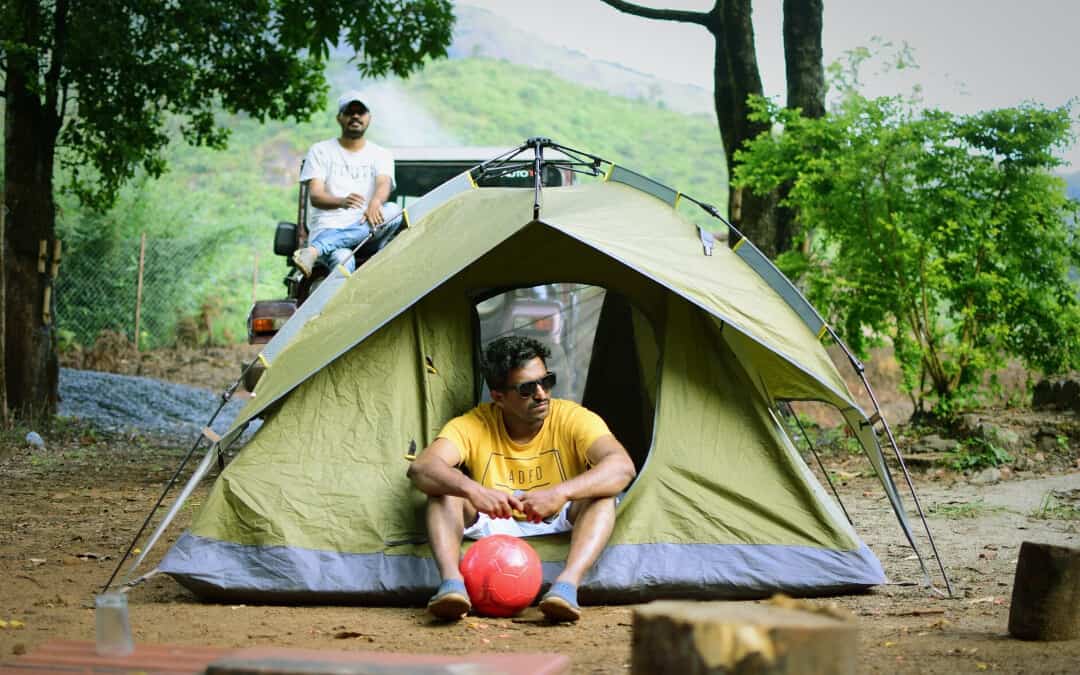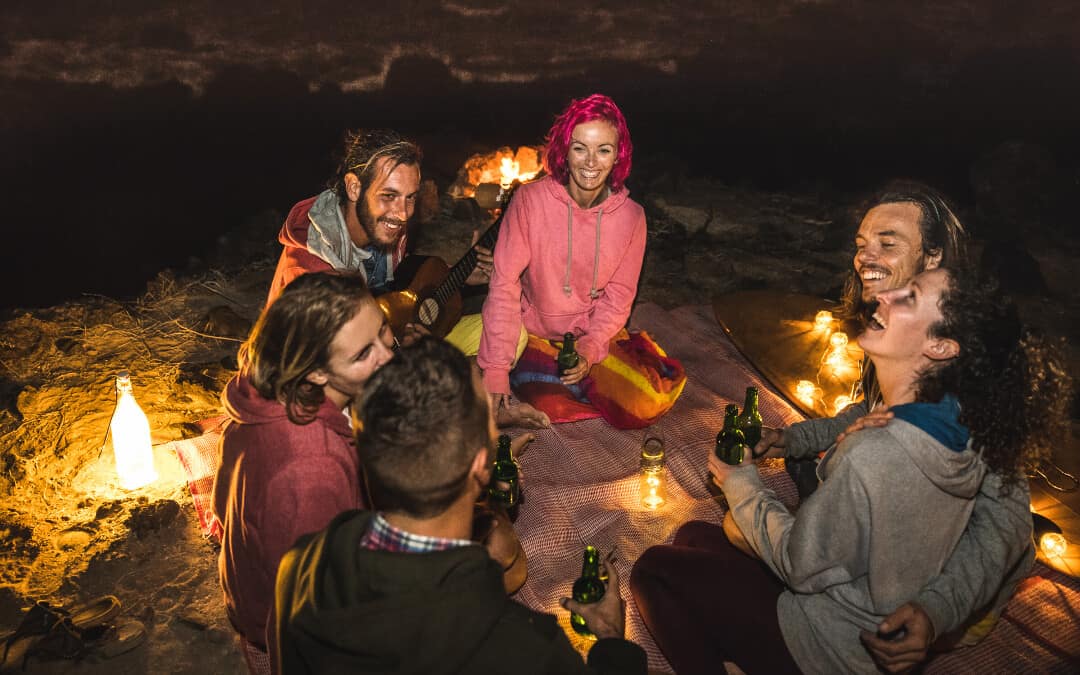It’s one of the most frightening things that can happen while camping: you’re relaxing in your tent or exploring nature, when all of a sudden a thunderstorm rumbles in the distance. If you’re at a campground, it’s best to seek shelter and wait out the storm inside. But if you’re out in the backcountry and you find yourself camping in a thunderstorm, your options may be more limited limited. You may be wondering how to keep safe during a thunderstorm while still being able to enjoy yourself at camp (spoiler: it’s not staying in your tent!).
Here are some tips to keep in mind for what you should do before and during a storm.
The Dangers of Thunderstorms While Camping
While being struck by lightning isn’t the most common cause of injury and death for campers and outdoor enthusiasts, it is certainly a very real threat that should be taken seriously. According to Weather.gov, 261 people were killed by lightning during a recent 8-year period (2006-2013), and there’s no reason these numbers would have declined over the past 8 years-at least 20 people are struck by lightning each year in the United States alone, according to the National Weather Service.
Being struck by lightning is relatively rare, but is much more likely for those who spend more time outdoors. Fishermen are three times more likely than others to be struck and killed by lightning, and campers and hikers are twice as likely.
Lightning storms are most common from June through August, which also happens to be the most popular time for camping and various outdoor activities. Because of this, the majority of lighting-related deaths occur during these summer months.
One reason thunderstorms can be so dangerous is that lightning can strike up to 3-10 miles away from visible clouds. While it’s much more common to see a storm approaching from a distance, there have been many reported instances of a stray lightning strike crashing down from a clear blue sky. These bolts from the blue can catch anyone off-guard, so it’s a good idea to check the forecast when planning your next adventure, and ideally postponing if possible when there’s a chance of a thunderstorm in the area.
Getting to Safety: Where to Take Cover
When you hear the rumble of a thunderstorm, you might be tempted to pack up your tent and gear to protect your equipment, but time is of the essence and your life is more valuable than your gear.
Instead of trying to protect your tent, the first thing you should do is try to estimate how far away the lightning is (as long as you’re in a safe location). To do this, start counting as soon as you see the next bolt of lightning, and keep counting until you hear the rumble of thunder that accompanies it. Every 5 seconds that passes equals one mile (for example, if there is 15 seconds between the lightning and thunder, the storm is about 3 miles away).
The further the storm, the more opportunities you have to get to safety. There is still a chance for a stray bolt to strike far away from the storm, so that’s a risk you’ll need to factor in when deciding what to do.
The 30/30 Rule: If you can hear thunder within 30 seconds of seeing the lightning, the storm is already close enough to be a threat-it’s important to act very quickly if so. Once the thunderstorm has passed, you’ll need to wait at least 30 minutes before getting back to what you were doing before the storm struck.
Taking Cover in a Shelter
If there’s an opportunity to wait out the thunderstorm in a safe shelter nearby, you should absolutely do so because there are no truly safe places outdoors-only safer areas. Below are some of the most common safe shelter options that may be nearby on your camping trip.
Large Enclosed Buildings
Ideally, you should try to take shelter indoors in a large, enclosed building as quickly as possible.
Park Ranger Stations
If there are no large buildings within a short distance, a park ranger station is a great hideout if one is nearby.
Campsite Bathrooms (with Plumbing)
If those options aren’t available, a bathroom with plumbing and electricity is another good choice (if one happens to be nearby). The plumbing and wiring can help ground lightning strikes. Many campgrounds and national parks offer these types of bathrooms, but you may not have this luxury on more backwoods camping adventures.
Your Vehicle
Another potential safe haven is your car or vehicle if it’s nearby. While it may seem like a cage of metal surrounding you could do more harm than good, the metal around your car acts as a conductor for lightning, meaning that it’ll direct the lightning around you down through your tires to strike the earth and not you. Just be sure not to touch your doors or the steering wheel while waiting.
Very Important: If you’re camping in a thunderstorm, do not take shelter in your car if it does not have a hard top. Convertibles, some models of jeeps, and other similar vehicles do not offer the protection and safety that hard top vehicles do.
Unfortunately, a lightning strike can damage your car and potentially cause issues with the electrical system, tires, windows, and more. (However, this damage would occur whether or not you were in the vehicle.)
Staying Safe With No Shelter Nearby
If you’re far out in the wilderness away from civilization, hiding out in a nearby building or your vehicle may not be an option. While this scenario is more dangerous, there are ways to help reduce your chances of injury or death from being struck. Remember: no place outside is completely safe when a thunderstorm is nearby.
Get Out of Your Tent
If you’re in your tent when the weather worsens, get out of it. Tents offer no real protection and can channel bolts through poles, while also striking you. While it’s true your tent won’t attract bolts, it may be struck if it’s taller than the objects in its surrounding.
There are some prototypes for a lightning-proof tent, but so far they are not in mass-production and aren’t designed for comfort or long-term camping. One day you may be able to own a tent that’s designed for dangerous storms, but in the meantime it’s better to stick with a comfortable tent and follow these guidelines.
Get to Lower Ground
Lightning is more likely to strike more frequently along mountains, hills, and ridgelines, so if you find yourself on higher ground as the weather worsens, get to lower ground as quickly (and safely) as possible.
Stay Away From Tall Objects
Trees, poles, fences, and other tall objects can attract lightning, so you should stay away from them until the storm has passed. If you’re too close to tall objects, you can be struck by side splashes or ground currents (discussed below).
Avoid Cliffs
Do not try to wait out the storm under a nearby cliff or rocky overhang-bolts can run down the side and strike you.
Stay Away from Water
Get out of the water if you’re in a river, lake, pond, or the ocean, as lightning often strikes water. Water is a potent conductor for electricity, and it is much more likely to strike you if you’re too close.
Stay Out of Unsafe Buildings
Similar to your tent, outhouses and picnic shelters are great when you’re camping but should be avoided during bad weather, as they aren’t built for safety. If the building does not have plumbing or electricity, it’s probably not a safe place to hide out.
Don’t Walk in Open Fields
Lightning tends to strike the tallest objects around, and if you’re in field with nothing surrounding you, you’re the tallest object around. If there’s nothing but flat open land for miles, your best bet is to crouch down with your head tucked into your knees and your hands over your ears. Do not lay down, as you need to maintain minimal contact with the ground to reduce your chances of being struck.
Spread Out
If you’re with a group of people when you’re camping in a thunderstorm, have everyone spread out to help reduce the chance of multiple injuries in the event that a bolt strikes one of your group members.
Dry Ravines & Depressions
If you can find a dry ravine or a depression that takes you lower than the surrounding ground, go into it and crouch until the weather improves.
How Lightning Can Strike
When you think of a person being struck by lightning, you probably picture a bolt coming down from the sky and making direct contact. While that’s one way it can strike, it’s not the only way-and it helps to know the other ways so you can be armed with helpful knowledge in the event of an emergency.
Direct Strikes
Direct strikes are fairly rare when compared to the other types of strikes, but they’re also the most lethal. These strikes usually hit people who are standing or walking in open fields or clearings during a storm. When a strike makes direct contact, part of the bolt often goes through the body, while the other part runs along the victim’s skin. The current inside the body can wreak havoc on the cardiovascular system or nervous system, while the bolt across the skin can cause severe burns.
Ground Currents
These are the most common type of strike that results in injuries and death. This type of strike occurs when a bolt hits an object such as a tree and travels along the ground away from the object. The bolt will typically enter the body through whatever part is closest to the strike, and will exit on the opposite side-the farther the bolt has to travel to exit the body, the more lethal it is. Additionally, these strikes can travel far (up to or over 100 feet), which makes them even more dangerous.
Side Splashes
Side splash strikes (also referred to as a side flash) often occur when a person has taken cover under a nearby tree. The bolt will strike a tree and part of it can jump from the taller object to the person on its way down to the earth. The best way to reduce your odds of being struck by a side splash is to stay several feet away from trees and taller objects.
Upward Streamers
An upward streamer occurs when the downward-moving leader gets close to the ground and causes the channel of air directly above a person or object to become positively charged, which can cause the charge to jump and complete the channel. If a person is in the way of the streamer when it connects with the leader, it can shock them and cause injury or death.
Conduction
Metal does not attract lightning, but it is a great conductor and can help electricity travel far. If you’re taking shelter in a building, be sure not to touch any faucets or showerheads, windows, doors, or plugged-in electronics. If you’re taking shelter outside, stay away from fences, piping, other metal objects, and wet rope.
What to do if Someone is Struck
If someone you’re with is struck, it’s important to act quickly to improve your chances of saving their life and reducing lasting injuries.
Call for Assistance
The first thing you need to do is call 911 to request assistance. Give directions as clearly as possible so they can arrive quickly.
Get Somewhere Safe
If there is still lightning in the area, make sure you and the victim are both in a safe location. If you’re in an open field or near a tree, it may be a good idea to move them to a safer location if possible-while you aren’t normally supposed to move an injured person, lightning strike victims normally will not have any broken bones or issues that would make moving them more dangerous (unless they fell or were thrown by the impact). However, if the victim is bleeding or seems to have a broken bone, do not try to move them.
Render Aid
If the victim is laying on cold and/or wet terrain, put clothing or a blanket under them if possible to help fight hypothermia. Check the victim for a pulse and make sure they’re breathing. Place two fingers directly below the jaw to feel for a pulse, and place your ear to their mouth to listen for signs of breath. If the person does not have a pulse, immediately start performing CPR (cardiac compressions). If they aren’t breathing, provide mouth-to-mouth resuscitation. Continue rendering aid until medical assistance arrives.
Staying Safe While Camping in a Thunderstorm
With all of these safety tips in mind, you’re now more prepared in the event that a thunderstorm rolls in during your trip. The best way to stay as safe as possible is to plan ahead and postpone your trip if there’s a chance of inclement weather.
Even if a thunderstorm is unlikely, it is well worth the time and effort to have a plan in the event that one occurs. Camping and enjoying the outdoors is a much better past-time when you’re prepared for any potential emergencies!




0 Comments